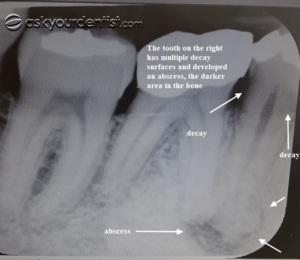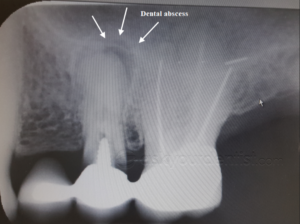A dental abscess is a bag of infection that contains bacteria, its products, own body cells and blood. The content of the bag is called pus. The abscess develops in connection with an infected tooth or an infected gum.
If the bacteria (decay) in a tooth cavity is left untreated it will reach the pulp inside the tooth and infects it. When the number of bacteria grows inside the pulp, it leaves the root of the tooth and spreads to the tissue around it. The body senses that and starts to encase the infectious bacteria. In some cases, your dentist may decide to drain the abscess to stop it from growing. Sometimes an abscess might also drain itself out in the mouth or through the chin. When drained, the pressure inside the abscess is released and the pain eases.
If the abscess is not drained, it will keep growing causing damage to the surrounding tissue and spreading to affect other body organs. For example, an abscess developing from a canine in the upper jaw can affect the eye and even spread to the brain if left untreated. And an abscess developing in the lower jaw can spread to the neck with severe consequences.
How to Treat an Abscess:
Antibiotics are used to control and fight an abscess till the tooth or the gum infection is treated. The tooth can be treated with root canal treatment and the gum can be treated with deep scaling if the cause of the abscess is trapped under the gum.
How do I know I have an abscess?
- The infected area is dark red, swollen and tender to the touch. The infected tooth is usually raised, slightly loose and painful.
- You may feel generally weak and unwell with or without fever.
- Sometimes you may even feel that the lymph nodes in your neck are hardened.
Should I keep taking antibiotics to prevent the abscess from coming back?
No. If the main cause is not treated the abscess will come back and the bacteria will become more resistant to antibiotics and therefore much harder to get rid of. Other oral infections can have the same symptoms as an abscess. Contact your dentist or doctor for an accurate diagnosis.


